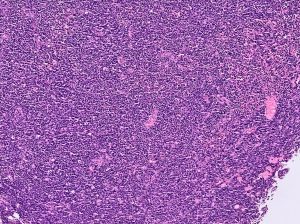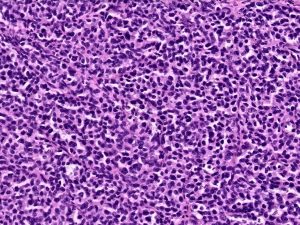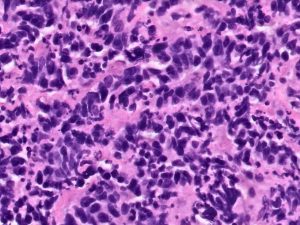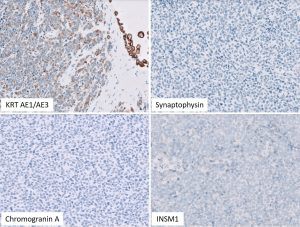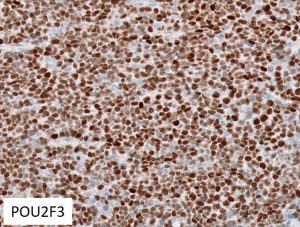CASE OF THE MONTH
A female patient in her 70s presented with gross haematuria. Cystoscopy revealed an exophytic tumour in the right bladder wall. Transurethral resection was carried out.
Contributors :
Laurence A Galea (1), Sree Appu (2)
1. Department of Anatomical Pathology, Melbourne Pathology, Sonic Healthcare, Victoria, Australia
2. Department of Surgery, Monash University, Victoria, Australia
What is the correct diagnosis?
a. Diffuse large B cell lymphoma
b. Ewing sarcoma
c. Small cell neuroendocrine carcinoma
d. Melanoma
e. NUT carcinoma
Small cell neuroendocrine carcinoma
Small cell neuroendocrine carcinoma
Sections of the TURBT specimen showed a tumour mostly composed of sheets of neoplastic with high nuclear to cytoplasmic ratios, hyperchromatic nuclei with fine chromatin and minimal cytoplasm. Mitotic figures and apoptotic bodies were easily identified. The cells were positive for KRT AE1/AE3 and focally positive for KRT 7 in a perinuclear dot-like fashion. CD56 was focally positive. Negative stains included KRT 20, 34e12, p63, GATA3, synaptophysin, chromogranin A, INSM1, TTF-1, CD45, SOX10, myogenin, CD99 and NUT. POU2F3 showed diffuse nuclear expression. The Ki-67 index was more than 90%. About 20% of the tumour was composed of conventional type urothelial carcinoma composed of nests and interconnecting trabecula of epithelioid cells invading into the lamina propria (not shown in the images provided). This component expressed KRT AE1/AE3, KRT 7, KRT 20, 34e12, p63 and GATA3. Synaptophysin, chromogranin A, INSM1, CD56 and POU2F3 were negative. A diagnosis of mixed small cell neuroendocrine carcinoma (SCC) with a small component of conventional urothelial carcinoma was rendered.
Small cell carcinomas of the lung (SCLC) are now molecularly classified based on lineage-specific transcription factor expression, including POU class 2 homeobox 3 (POU2F3), achaete-scute homologue 1 (ASCL1), neurogenic differentiation factor 1 (NEUROD1), and yes-associated protein 1 (YAP1) [1]. While SCLC is considered a tumour of pulmonary neuroendocrine (NE) cells and therefore typically expresses NE-phenotype markers, some cases of SCLC show low or absent NE expression. POU2F3 is expressed in these NE-low/absent SCLC and is mutually exclusive of ASCL1 and NEUROD1. POU2F3 is a master regulator of tuft cell differentiation from which POU2F3 expressing SCLC is thought to arise [2]. Tuft cells are rare solitary cells found between the basement membrane and the epithelial cells in various mucosal sites and are thought to have an immunomodulatory and chemosensory function [3].
Molecular studies have shown that similar lineage-specific transcription factors (ASCL1, NEUROD1 and POU2F3) define three molecular subtypes in SCC of the urinary bladder [4]. Recently Akbulut et al. identified five distinct molecular subtypes in bladder SCC based on the immunohistochemical expression of ASCL1, NEUROD1, and POU2F3 in a large cohort of bladder neuroendocrine carcinomas: ASCL1+/NEUROD1−, ASCL1−/NEUROD1+, ASCL1+/NEUROD1+, POU2F3+, and ASCL1−/NEUROD1−/POU2F3−. POU2F3+ tumours were mutually exclusive with those expressing ASCL1 and NEUROD1. They also exhibited lower expression of traditional neuroendocrine markers, as in this tumour [5]. POU2F3 expression was associated with shorter recurrence-free survival and overall survival.
In this tumour the keratin expression and negative CD45, SOX10 and CD99 immunohistochemistry (IHC) excluded other differential diagnoses including diffuse large B cell lymphoma, melanoma and Ewing sarcoma. The negative NUT IHC excluded NUT carcinoma. POU2F3 IHC can be of diagnostic utility in challenging cases of urinary tract SCC with absent or low NE marker expression.
1. Rudin CM, Poirier JT, Byers LA, Dive C, Dowlati A, George J, Heymach JV, Johnson JE, Lehman JM, MacPherson D, Massion PP, Minna JD, Oliver TG, Quaranta V, Sage J, Thomas RK, Vakoc CR, Gazdar AF (2019) Molecular subtypes of small cell lung cancer: a synthesis of human and mouse model data. Nat Rev Cancer 19:289-297.
2. Huang YH, Klingbeil O, He XY, Wu XS, Arun G, Lu B, Somerville TDD, Milazzo JP, Wilkinson JE, Demerdash OE, Spector DL, Egeblad M, Shi J, Vakoc CR (2018) POU2F3 is a master regulator of a tuft cell-like variant of small cell lung cancer. Genes Dev 32:915-928.
3. O’Leary CE, Schneider C, Locksley RM (2019) Tuft Cells-Systemically Dispersed Sensory Epithelia Integrating Immune and Neural Circuitry. Annu Rev Immunol 26;37:47-72.
4. Feng M, Matoso A, Epstein G, Fong M, Park YH, Gabrielson A, Patel S, Czerniak B, Compérat E, Hoffman-Censits J, Kates M, Kim S, McConkey D, Choi W (2023) Identification of Lineage-specific Transcriptional Factor-defined Molecular Subtypes in Small Cell Bladder Cancer. Eur Urol 27:S0302-2838(23)02830-0.
5. Akbulut D, Whiting K, Teo MY, Tallman JE, Ozcan GG, Basar M, Jia L, Rammal R, Chen JF, Sarungbam J, Chen YB, Gopalan A, Fine SW, Tickoo SK, Mehra R, Baine M, Bochner BH, Pietzak EJ, Bajorin DF, Rosenberg JE, Iyer G, Solit DB, Reuter VE, Rekhtman N, Ostrovnaya I, Al-Ahmadie H. Differential NEUROD1, ASCL1, and POU2F3 Expression Defines Molecular Subsets of Bladder Small Cell/Neuroendocrine Carcinoma With Prognostic Implications. Mod Pathol. 2024 Oct;37(10):100557.
Laurence A Galea (1), Sree Appu (2)
1. Department of Anatomical Pathology, Melbourne Pathology, Sonic Healthcare, Victoria, Australia
2. Department of Surgery, Monash University, Victoria, Australia
Bladder
Small cell neuroendocrine carcinoma, bladder, POU2F3


